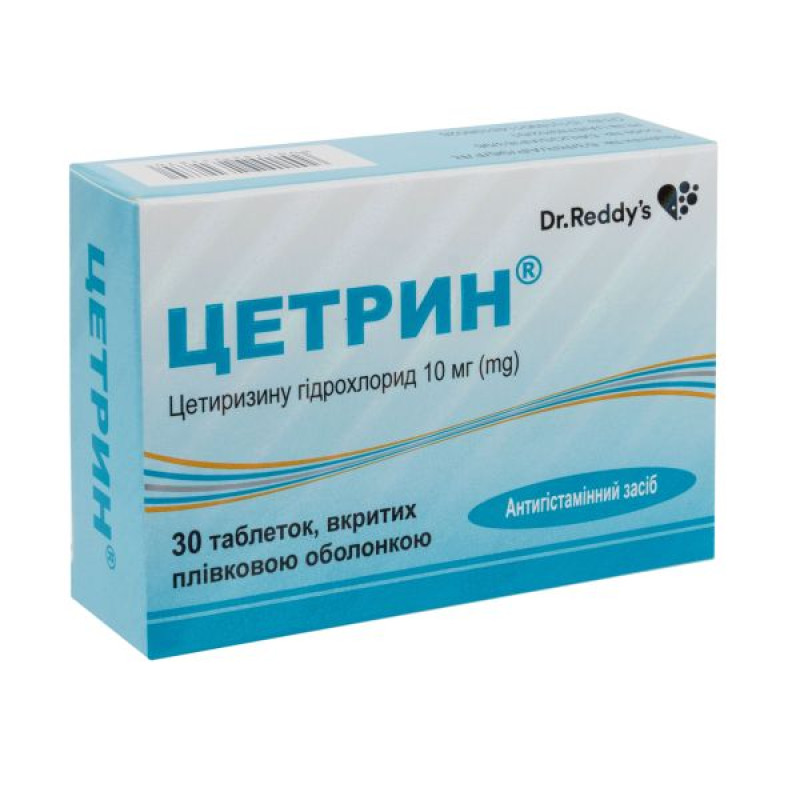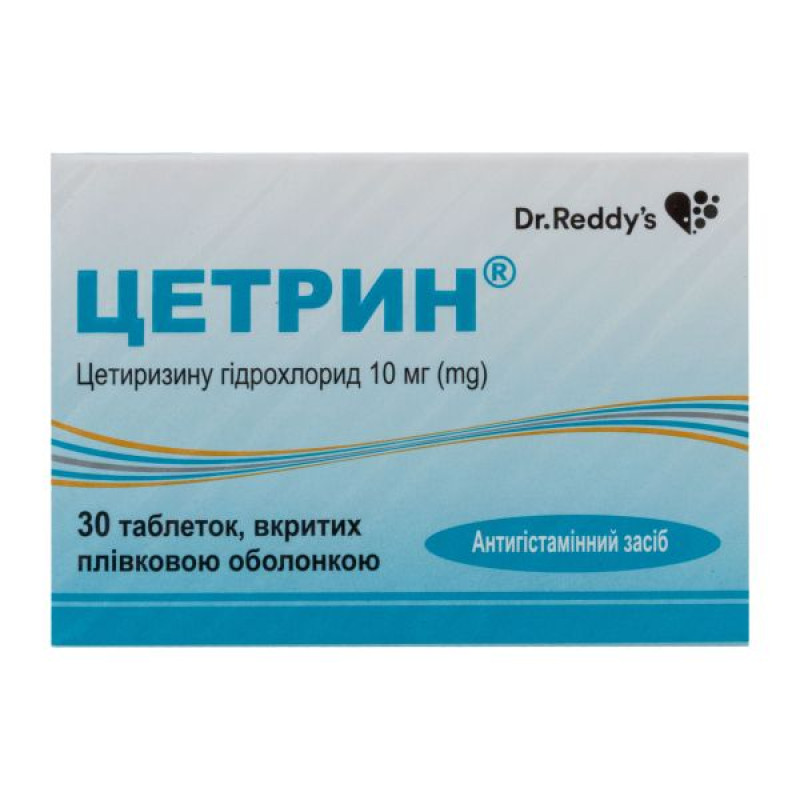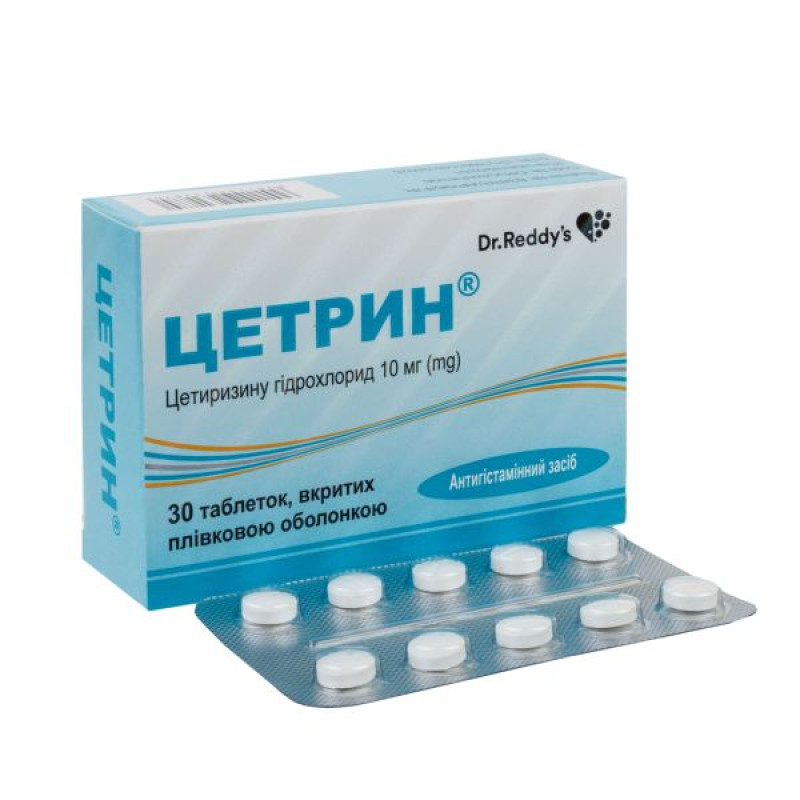Cetrin film-coated tablets 10 mg blister No. 30

Instructions Cetrin film-coated tablets 10 mg blister No. 30
Composition
active ingredient: cetirizine hydrochloride;
1 tablet contains cetirizine hydrochloride 10 mg;
Excipients: lactose monohydrate; corn starch; povidone; magnesium stearate; hypromellose; polyethylene glycols; titanium dioxide (E 171); talc; sorbic acid; polysorbates; dimethicone.
Dosage form
Film-coated tablets.
Main physicochemical properties: round biconvex tablets, film-coated, white in color, with a score line on one side and smooth on the other side.
Pharmacotherapeutic group
Antihistamines for systemic use. Piperazine derivatives. ATX code R06A E07.
Pharmacological properties
Pharmacodynamics
Cetirizine is a competitive histamine antagonist, a metabolite of hydroxyzine, blocks H1-histamine receptors. Prevents the development and alleviates the course of allergic reactions, has antipruritic and antiexudative properties, inhibits the development of the histamine-mediated early phase of the allergic reaction, limits the release of inflammatory mediators in the late stage of the allergic reaction, reduces the migration of eosinophils, neutrophils and basophils, reduces capillary permeability, prevents the development of tissue edema, relieves smooth muscle spasm. Eliminates the skin reaction to the introduction of histamine, specific allergens, as well as to cooling (with cold urticaria), reduces histamine-induced bronchoconstriction in mild bronchial asthma. It has almost no anticholinergic and antiserotonin effects. In therapeutic doses, it has almost no sedative effect. The onset of action after a single dose of 10 mg of cetirizine occurs within 20 minutes in 50% of people and within 1 hour in 95% of people. The effect lasts for at least 24 hours after a single dose. With course therapy, tolerance to the antihistamine effect of cetirizine does not develop. After discontinuation of treatment, the effect persists for up to 3 days.
Pharmacokinetics
It is rapidly absorbed from the digestive tract, the period of reaching the maximum concentration after oral administration is approximately 1 hour. The bioavailability of cetirizine when taken in the form of tablets and syrup is the same. Food does not affect the completeness of absorption, but prolongs the period of reaching the maximum concentration by 1 hour and reduces the maximum concentration by 23%. Binding to plasma proteins is 93%. In insignificant quantities, it is metabolized in the liver by O-dealkylation with the formation of a pharmacologically inactive metabolite (unlike other H1-histamine receptor blockers, which are metabolized in the liver with the participation of the cytochrome P450 system). It does not accumulate, 2/3 of the drug is excreted unchanged by the kidneys and approximately 10% - with feces. Systemic clearance is 53 ml/min.
The half-life in adults is 7-10 hours, in children 6-12 years old - 6 hours, 2-6 years old - 5 hours.
Patients with renal impairment
The pharmacokinetics of the drug in mild renal impairment (creatinine clearance below 40 ml/min) were similar to those in healthy volunteers. In patients with moderate renal impairment, the half-life was three times longer and the clearance was 70% lower than in healthy volunteers.
In patients undergoing hemodialysis (creatinine clearance below 7 ml/min), when using cetirizine in a single dose of 10 mg, the half-life was three times longer and the clearance was 70% lower than in healthy volunteers. Cetirizine is removed from plasma to a negligible extent during hemodialysis. Dosage adjustment is required in patients with moderate or severe renal impairment.
Indication
Nasal symptoms of seasonal and chronic allergic rhinitis (rhinorrhea, nasal itching, sneezing), non-nasal symptoms associated with conjunctivitis. Pruritus, urticaria of various types, including chronic idiopathic urticaria.
Contraindication
Hypersensitivity to cetirizine, to any of the excipients, to hydroxyzine or to any piperazine derivatives in history. Severe renal impairment with creatinine clearance less than 10 ml/min.
Interaction with other medicinal products and other types of interactions
A study of the interaction of cetirizine with pseudoephedrine, cimetidine, antipyrine, ketoconazole, erythromycin, azithromycin was conducted. The study did not confirm the pharmacokinetic interaction of these drugs with cetirizine. When taken together with theophylline, the clearance of cetirizine decreases, which can lead to accumulation and overdose of cetirizine. There is no data on the enhancement of the effect of sedatives when using cetirizine in therapeutic doses. However, the use of sedatives should be avoided while taking cetirizine. The volume of absorption of cetirizine is not reduced by food, although the absorption rate is reduced by 1 hour. Alcohol and/or central nervous system (CNS) depressants when used together with cetirizine can cause additional deterioration in attention and impaired performance, although cetirizine does not potentiate the effect of alcohol (at blood alcohol levels of 0.5 g/l).
Application features
Cetrin® is excreted by the kidneys, so in case of renal failure, the dose should be reduced to 5 mg per day. Elderly patients, provided that their kidneys function is normal, do not need to adjust the dose. When taken in therapeutic doses, no clinically significant interactions with alcohol were observed (at blood alcohol levels of 0.5 g/l). However, it is recommended to avoid simultaneous use of the drug with alcohol consumption. It is recommended to prescribe the drug with caution to patients with epilepsy and patients at risk of seizures, and not to use it in patients with hereditary galactose intolerance, Lapp lactase deficiency or glucose-galactose malabsorption.
This medicine contains lactose monohydrate. If you have been told by your doctor that you have an intolerance to some sugars, contact your doctor before taking this medicine.
Use with caution in patients prone to urinary retention (spinal injury, prostatic hyperplasia), as cetirizine may increase the risk of developing urinary retention.
Antihistamines suppress the skin allergy test, so before conducting it, the drug must be stopped 3 days before the test (withdrawal period).
Ability to influence reaction speed when driving vehicles or other mechanisms
Persons who drive vehicles or work with complex mechanisms should use the drug with caution, taking into account the reaction of their own body (see the section "Adverse reactions"). The therapeutic dose should not be exceeded.
Concomitant use of the drug with other CNS depressants may cause additional impairment of attention and impaired performance.
Use during pregnancy or breastfeeding
Pregnancy. There are insufficient data on the use of the drug during pregnancy. Animal studies do not indicate direct or indirect harmful effects with respect to pregnancy, embryonal/fetal development, parturition or postnatal development. Therefore, the drug should be prescribed to pregnant women only if, in the opinion of the physician, the benefit of the use outweighs the potential risk to the fetus.
Breastfeeding. Cetirizine is excreted in breast milk at concentrations that are 25-90% of those in plasma, depending on the time elapsed after administration. Therefore, caution should be exercised when prescribing the drug to breastfeeding women.
Method of administration and doses
Take orally, regardless of meals, with sufficient liquid (1 glass).
Children aged 6 to 12 years: 5 mg (half a tablet) twice a day.
Adults and children over 12 years of age: 10 mg (1 tablet) once a day.
Elderly patients with normal renal function do not require dose adjustment.
In patients with renal impairment, the dose should be adjusted on an individual basis, taking into account renal clearance, age and body weight.
Patients with moderate or severe renal impairment
There are no data on the benefit/risk ratio in patients with renal impairment. Since cetirizine is excreted mainly by the kidneys, if alternative treatment is not possible, the intervals between doses of the drug should be determined individually, depending on renal function.
Dosage for adult patients based on renal function is presented in Table 1.
Table 1. Dosage adjustment for adult patients depending on renal function:
| Kidney function | Creatinine clearance (ml/min) | Dosage and frequency |
| Normal | ≥ 80 | 10 mg once daily |
| Mild degree of disturbance | 50-79 | 10 mg once daily |
| Moderate degree of disturbance | 30-49 | 5 mg once daily |
| Severe degree of violation | < 30 | 5 mg once every 2 days |
| End-stage renal disease – patients undergoing dialysis | < 10 | contraindicated |
For children with impaired renal function, the dosage is adjusted individually, depending on the value of creatinine clearance and body weight.
No dose adjustment is required for patients with impaired liver function (provided that kidney function is normal).
The dose is adjusted for patients with impaired liver and kidney function (see Table 1).
The duration of treatment is determined by the doctor depending on the course of the disease.
Children
Cetirizine in tablet form is not prescribed for the treatment of children under 6 years of age, since this dosage form makes it impossible to make the necessary dose adjustment.
Overdose
Overdose of cetirizine is mainly associated with CNS effects or effects that may indicate anticholinergic activity. Adverse reactions reported after doses exceeding at least 5 times the recommended daily dose include: confusion, diarrhea, dizziness, fatigue, headache, malaise, mydriasis, pruritus, restlessness, sedation, drowsiness, stupor, tachycardia, tremor, and urinary retention.
In the initial stage, the patient should be induced to vomit. No antidote has been identified. Gastric lavage, administration of activated charcoal and laxatives are recommended. Dialysis is not effective. In severe cases, cardiovascular and respiratory functions should be carefully monitored.
Adverse reactions
Cetrin® at recommended doses is generally well tolerated by patients.
It is known that cetirizine in usual doses (10 mg per day) can cause adverse reactions from the central nervous system, drowsiness, increased fatigue, headache and dizziness. They are mild and transient in nature.
In some cases, paradoxical excitation of the CNS is observed.
Although cetirizine is a selective H1-receptor antagonist and has almost no anticholinergic activity, there have been isolated cases of delayed urination, impaired accommodation of the eye, and dry mouth. Liver function abnormalities have also been observed: increased liver enzymes and increased bilirubin concentration. In most cases, these symptoms resolved after discontinuation of cetirizine.
Clinical trials
As a result of clinical studies comparing cetirizine at a dose of 10 mg and other antihistamines at recommended doses, minor adverse reactions were observed from the central and peripheral nervous system (dizziness, headache); from the gastrointestinal tract (abdominal pain, dry mouth, nausea); from the respiratory system (pharyngitis); general disorders (increased fatigue) and mental disorders (somnolence). It is known that drowsiness (mental disorders) was observed more often in the study, but in most cases it was mild or moderate in severity.
Objective tests, as demonstrated in other studies, have proven that when the drug is used in recommended daily doses in healthy young volunteers, daily activities are not impaired.
There is evidence that among children aged 6 months to 12 years who were included in controlled clinical or pharmacoclinical studies, adverse reactions observed from the gastrointestinal tract (diarrhea) and from the respiratory system (rhinitis) were minor.
Post-registration experience
In addition to the adverse reactions reported in clinical trials and listed above, the following adverse reactions have been reported in post-marketing experience with cetirizine. These less frequently reported adverse reactions are classified according to their frequency: uncommon (≥ 1/1,000 to < 1/100); rare (≥ 1/10,000 to < 1/1,000); very rare (< 1/10,000) or not known (cannot be estimated from the available data).
Blood and lymphatic system disorders
Very rare: thrombocytopenia.
On the part of the immune system
Rare: hypersensitivity.
Very rare: anaphylactic shock.
Nutritional and metabolic
Frequency unknown - increased appetite.
From the psyche
Uncommon: mental excitement with anxiety (agitation).
Rare: aggression, confusion, depression, hallucinations, insomnia.
Very rare: nervous tic.
Frequency unknown: suicidal thoughts.
From the nervous system
Uncommon: paresthesia.
Rare: convulsions, movement disorders.
Very rare: dysgeusia, syncope, tremor, dystonia, dyskinesia.
Frequency unknown: amnesia, memory impairment.
On the part of the organs of vision and balance
Frequency unknown: vertigo.
From the heart
Rare: tachycardia.
Gastrointestinal tract
Uncommon: diarrhoea.
Hepatobiliary system
Rare: liver function abnormalities (increased transaminases, alkaline phosphatase, γ-glutamyltransferase and bilirubin).
Skin and subcutaneous tissue disorders
Uncommon: itching, rash.
Rare: urticaria.
Very rare: angioedema, fixed drug-induced erythema.
Renal and urinary disorders
Very rare: dysuria, enuresis.
Frequency unknown: urinary retention.
General disorders
Uncommon: asthenia, malaise.
Rare: edema.
Changes in laboratory and instrumental research results
Rare: weight gain.
Expiration date
3 years.
Do not use after the expiry date stated on the packaging.
Storage conditions
Store in a dry, dark place out of reach of children at a temperature up to 25 °C.
Packaging
10 tablets in a blister, 3 blisters in a cardboard box.
Vacation category
Without a prescription.
Producer
LLC "Dr. Reddy's Laboratories »
Location of the manufacturer and its business address
Precinct No. 42, 45, 46, Bachupali Village, Medchal Malkaigiri District, Telangana State, Bachupali Mandal, India
There are no reviews for this product.
There are no reviews for this product, be the first to leave your review.
No questions about this product, be the first and ask your question.








